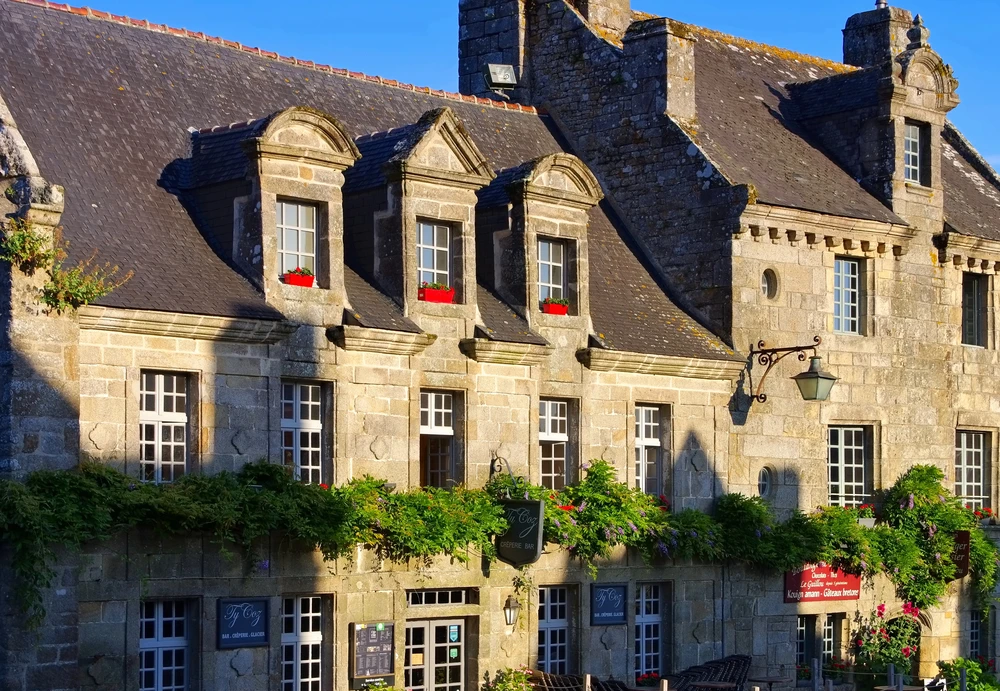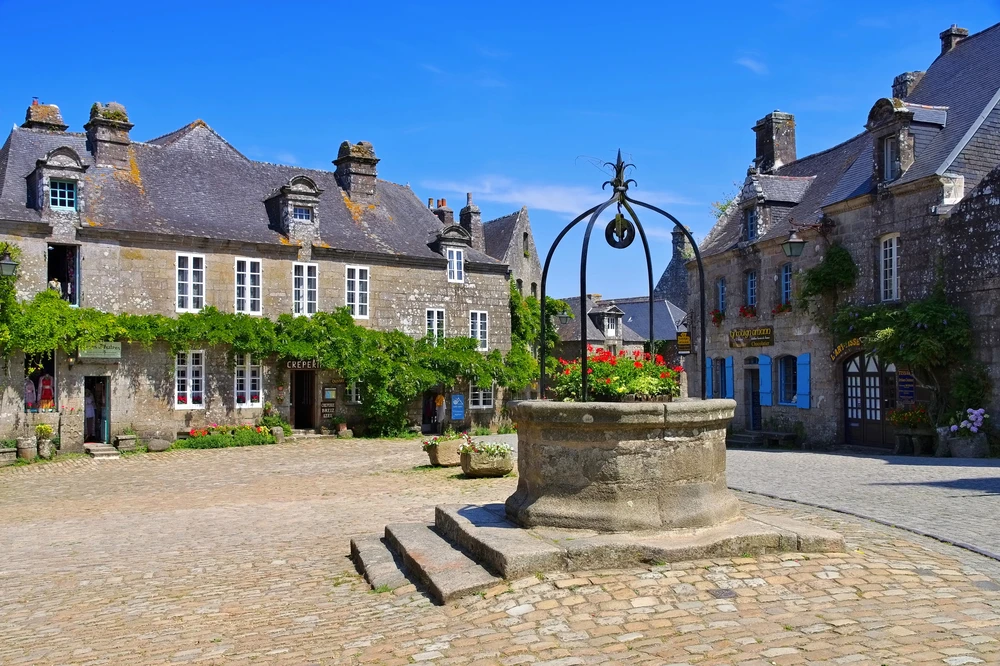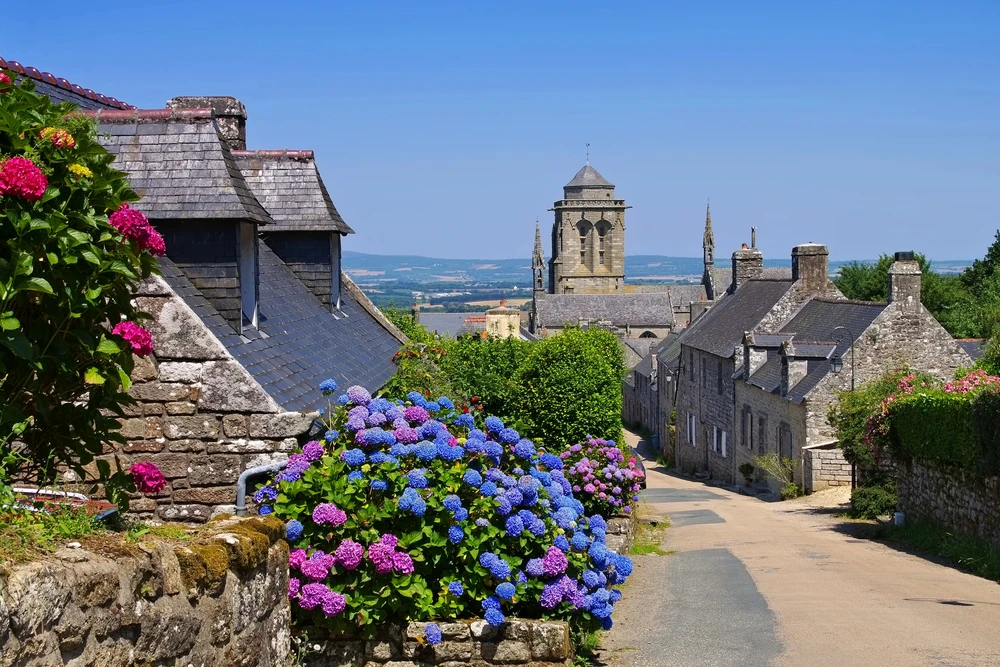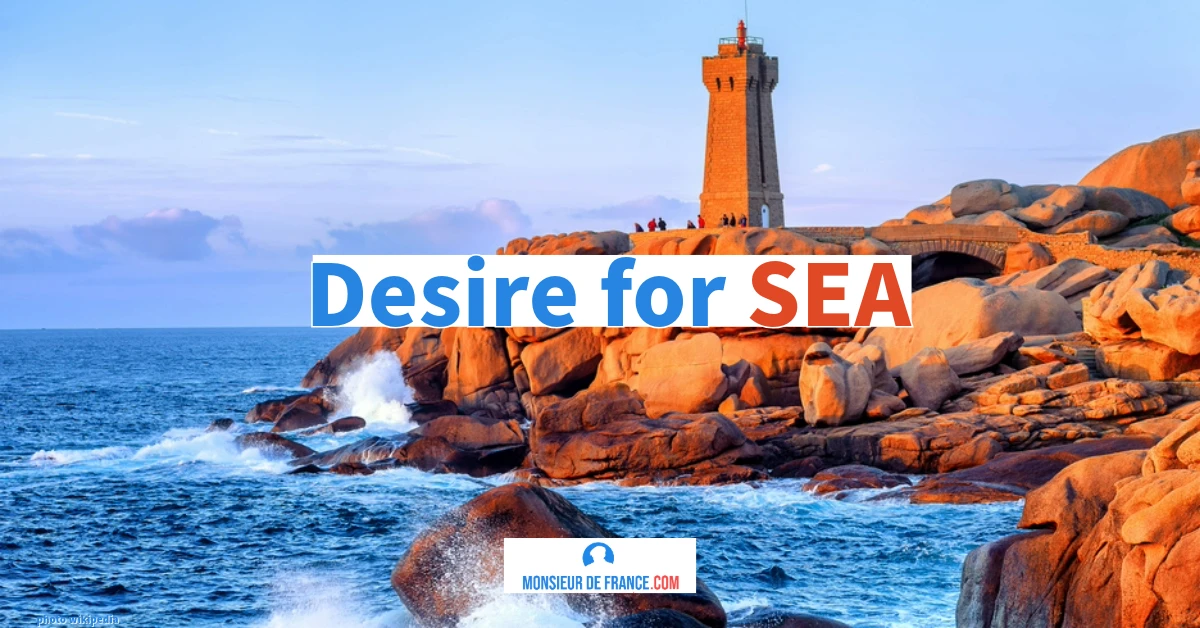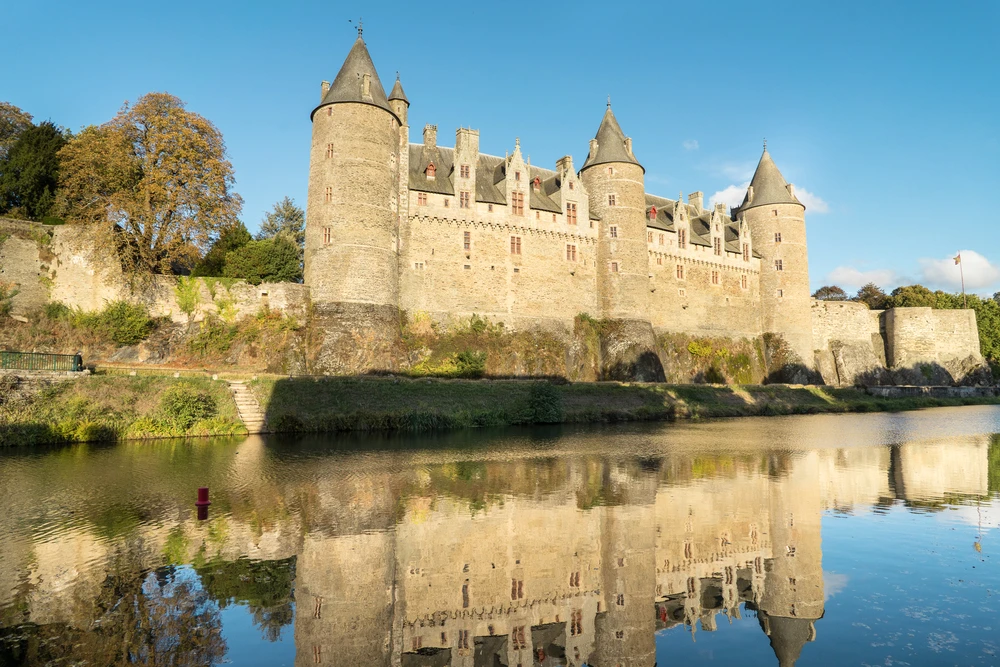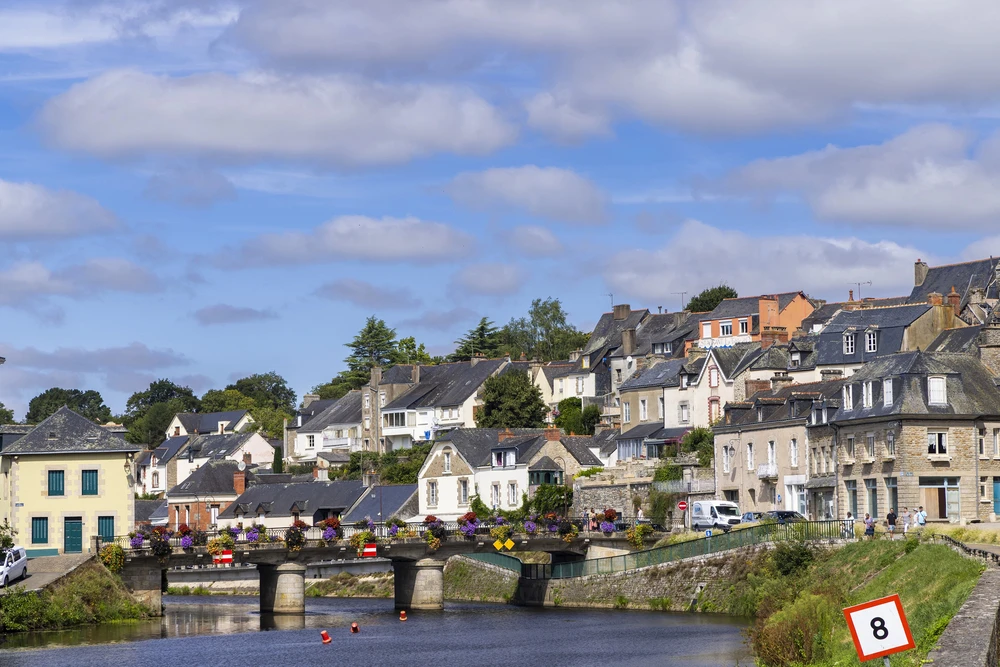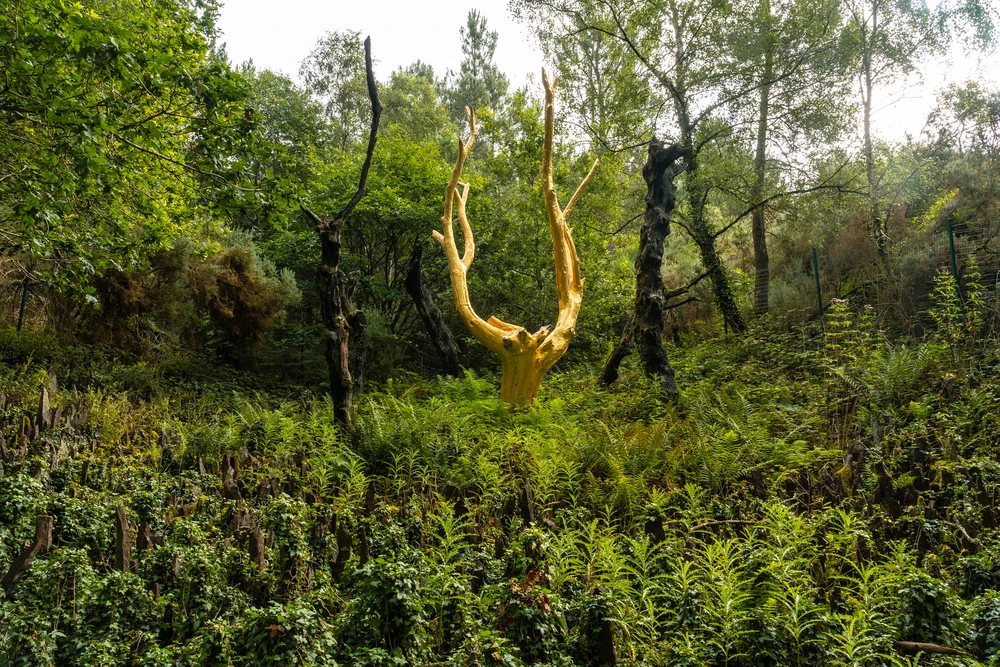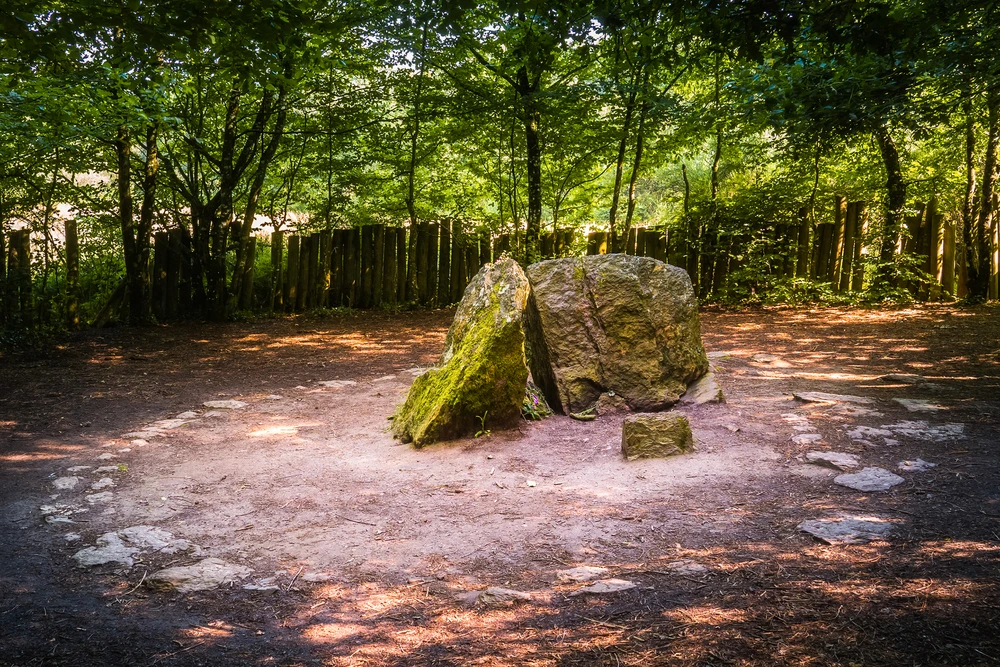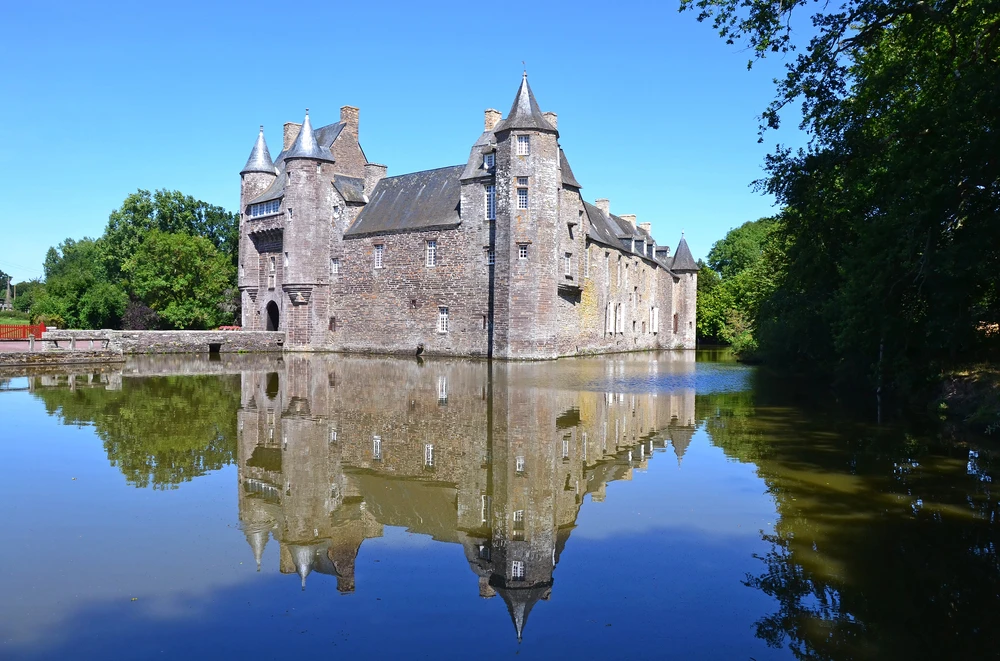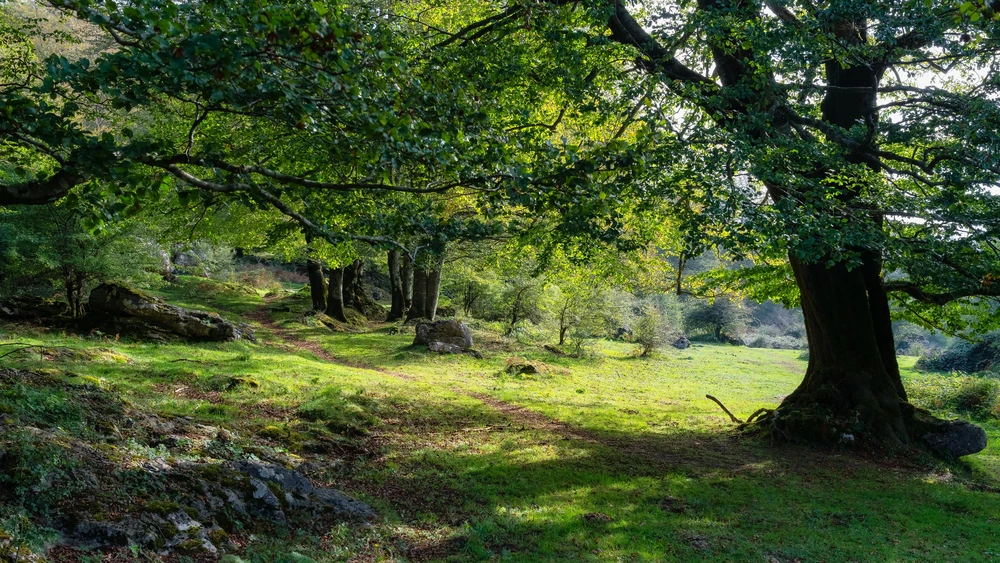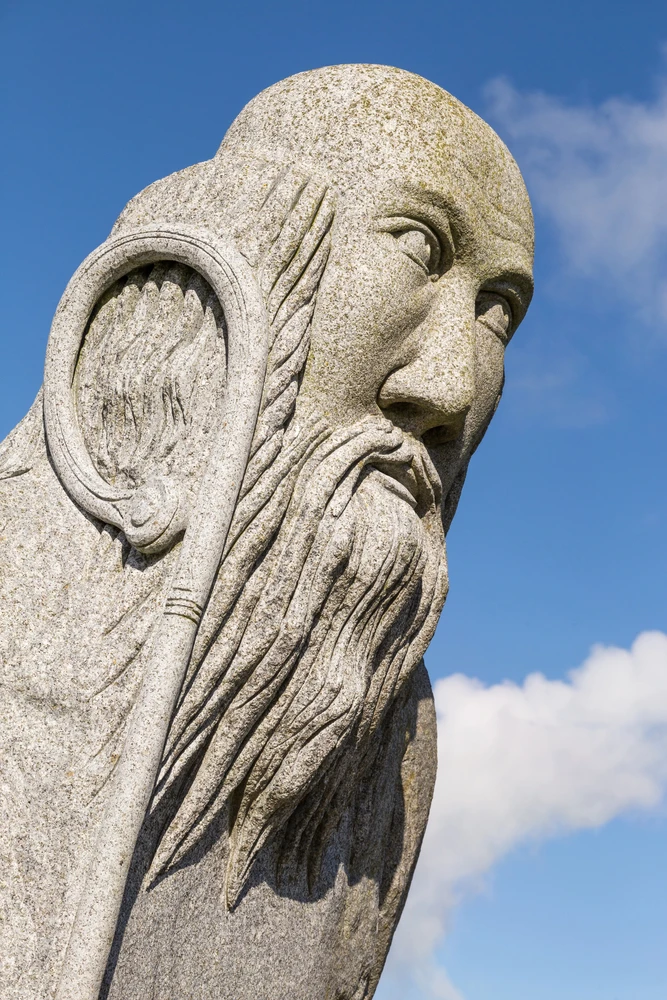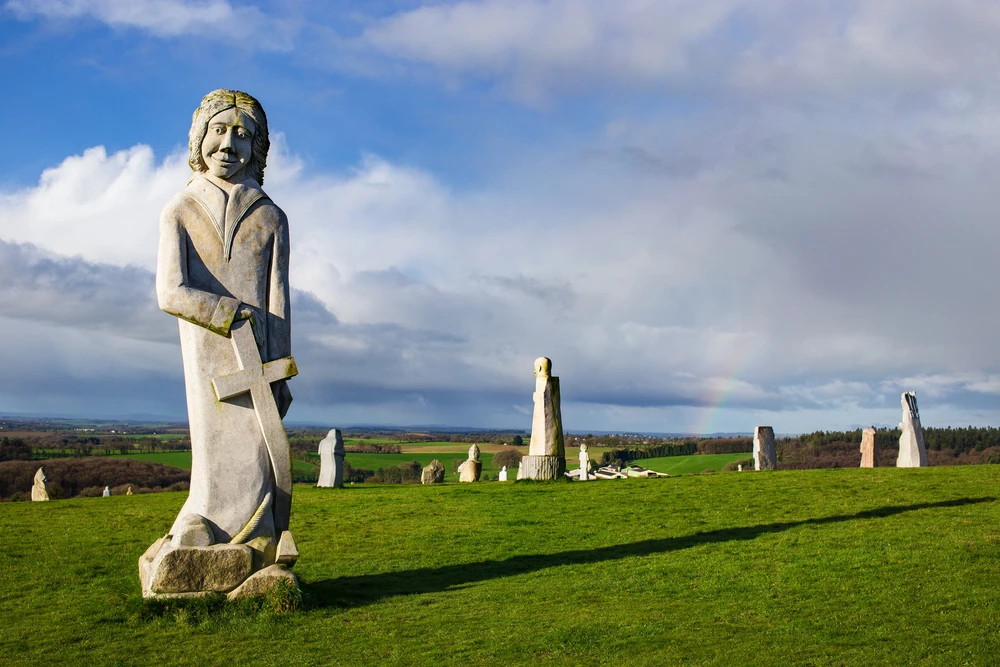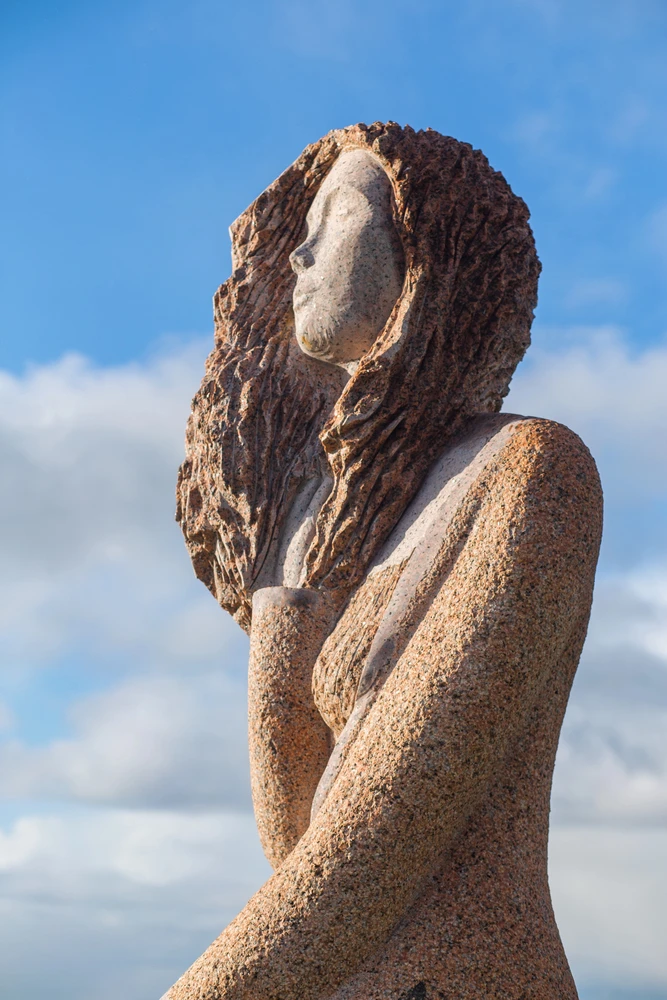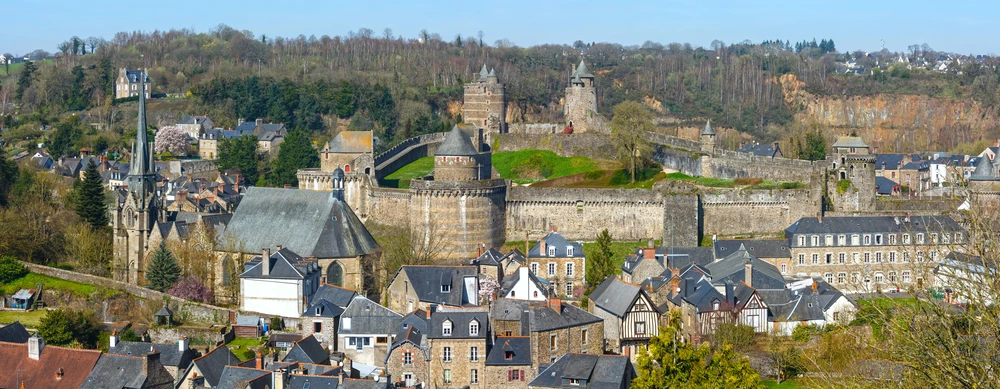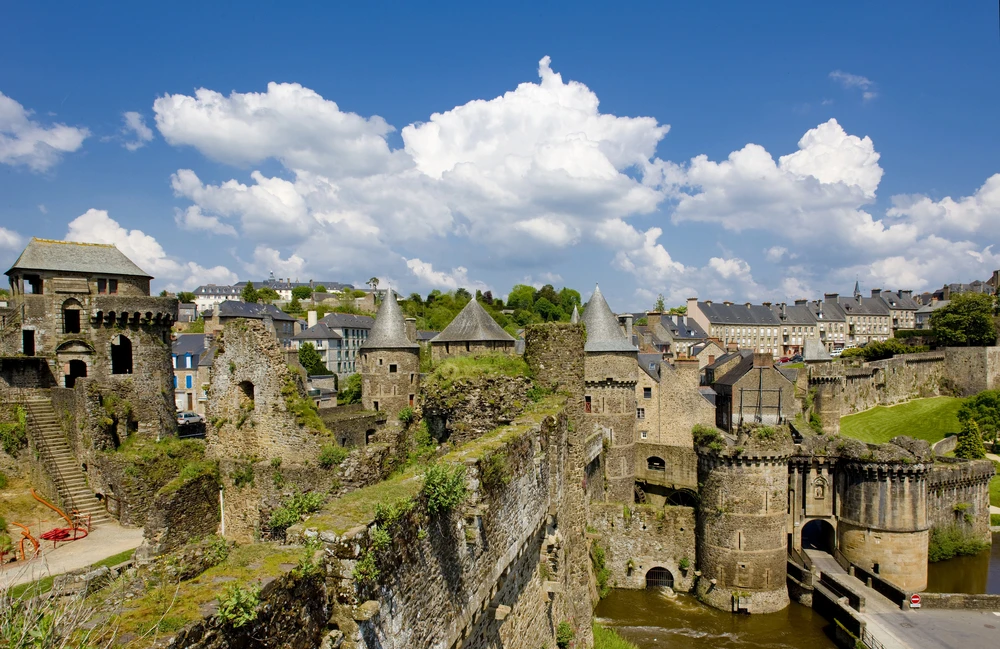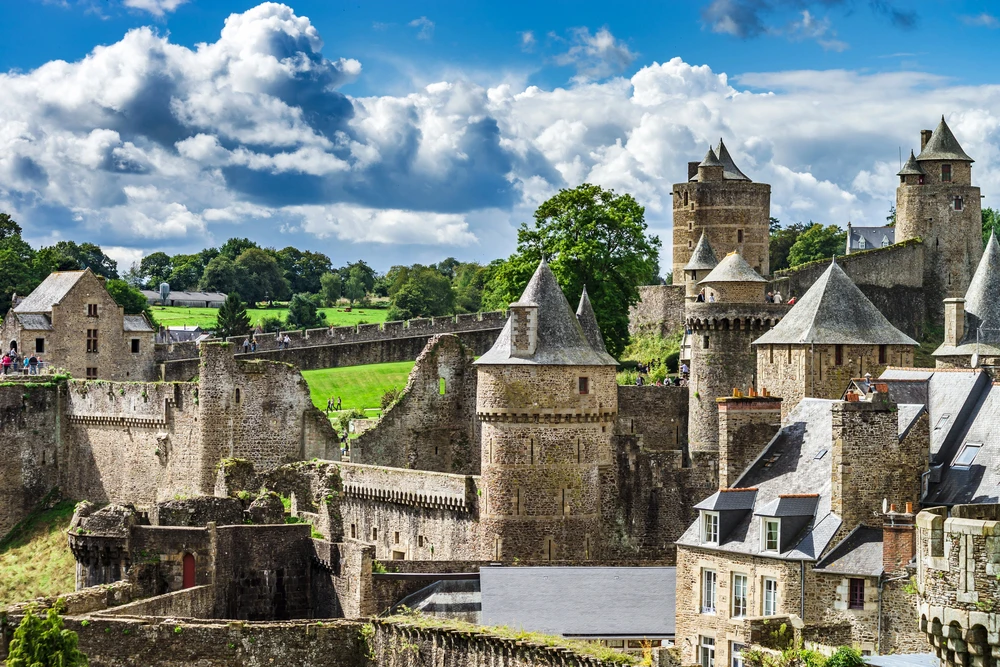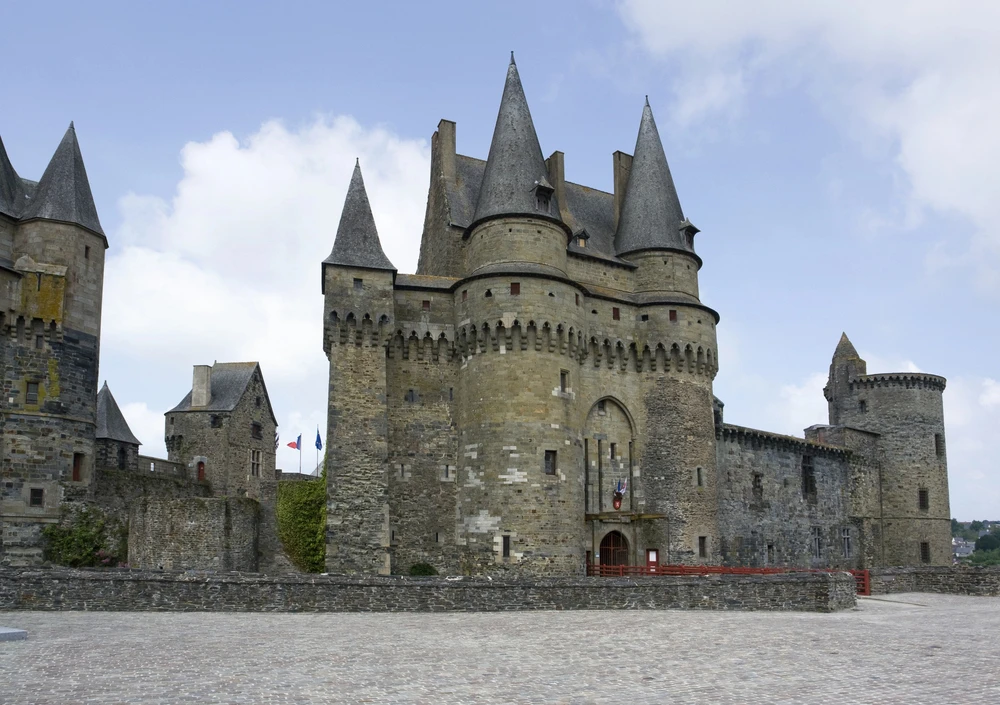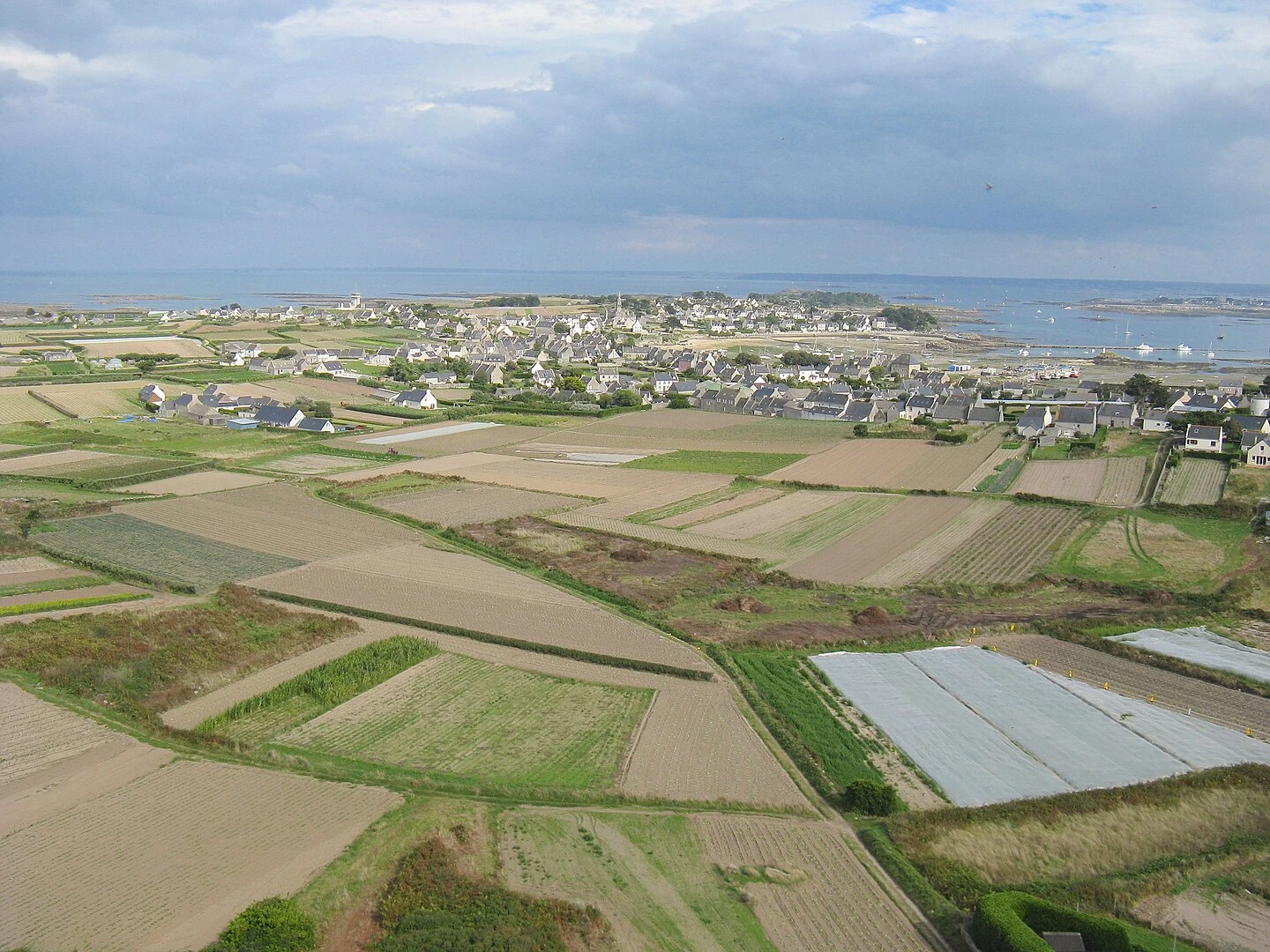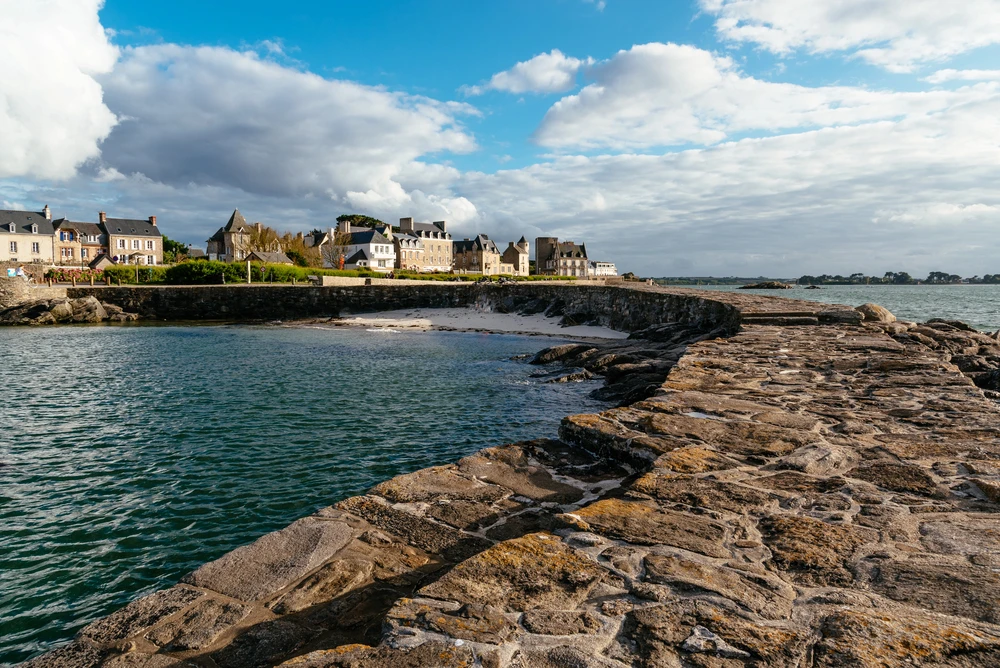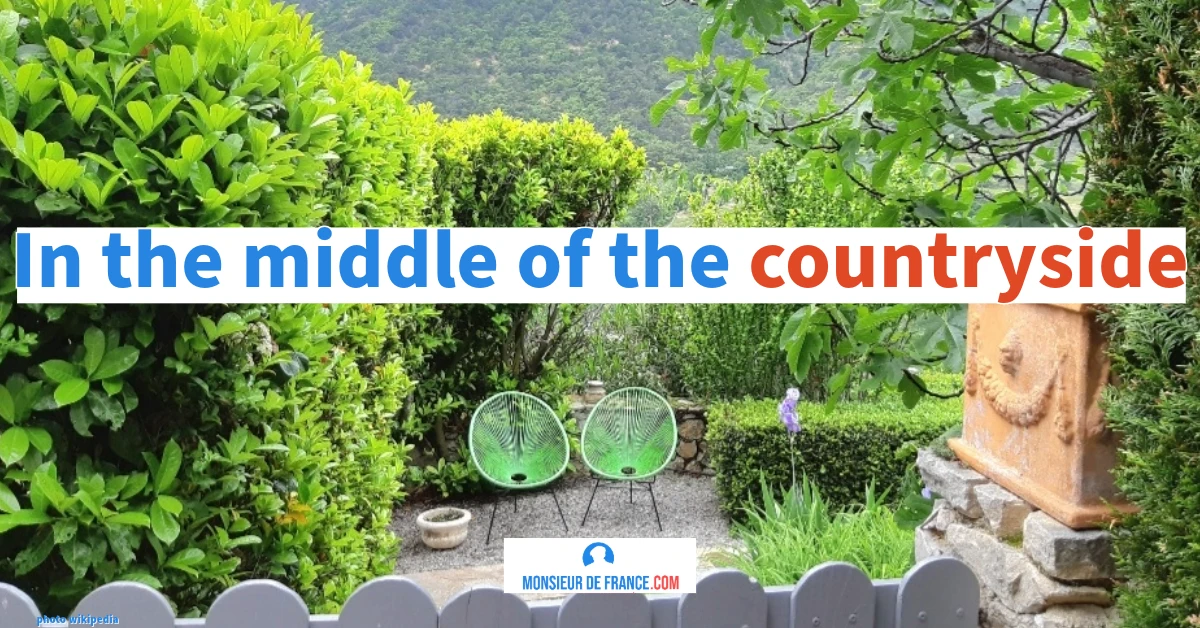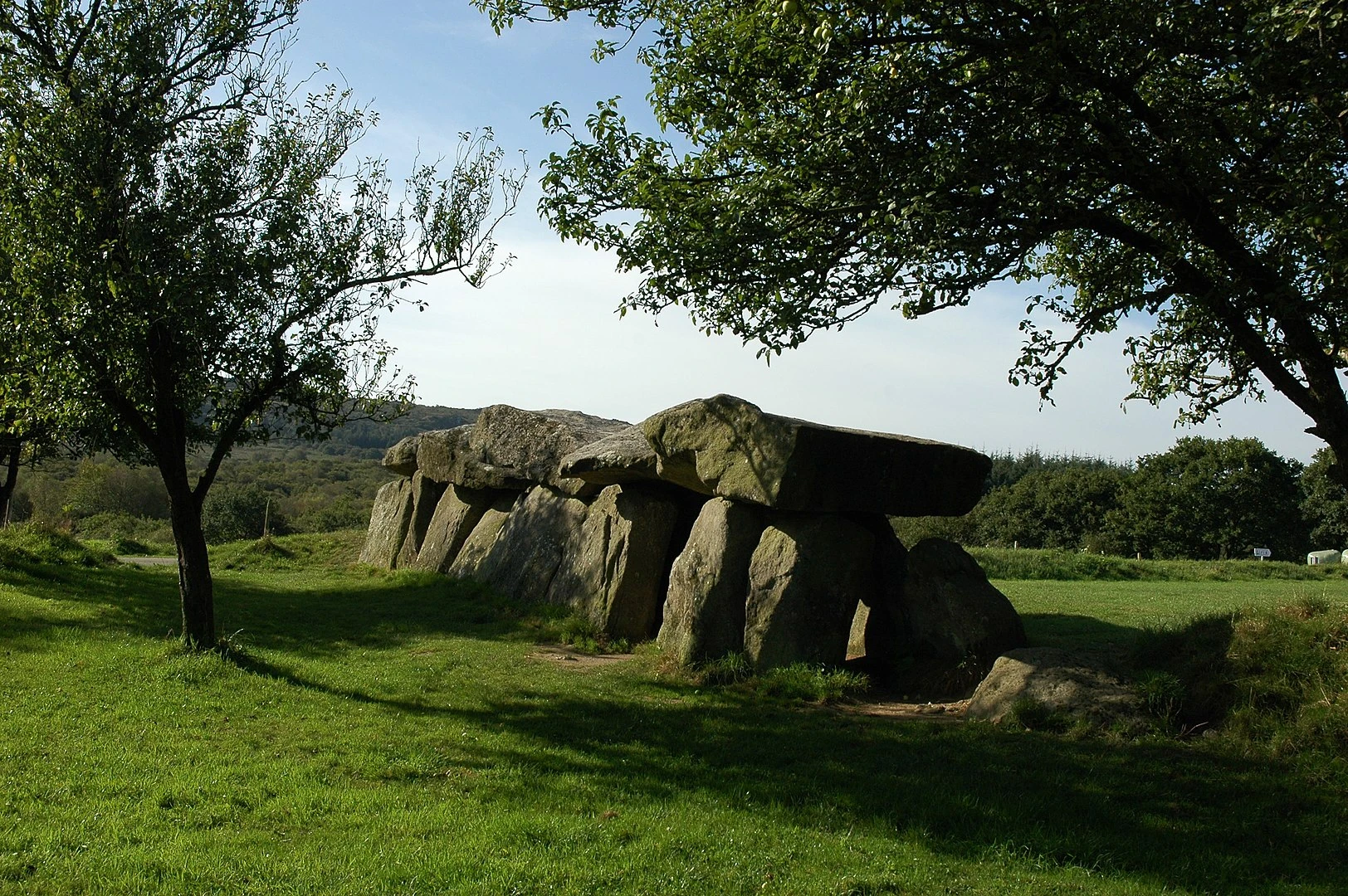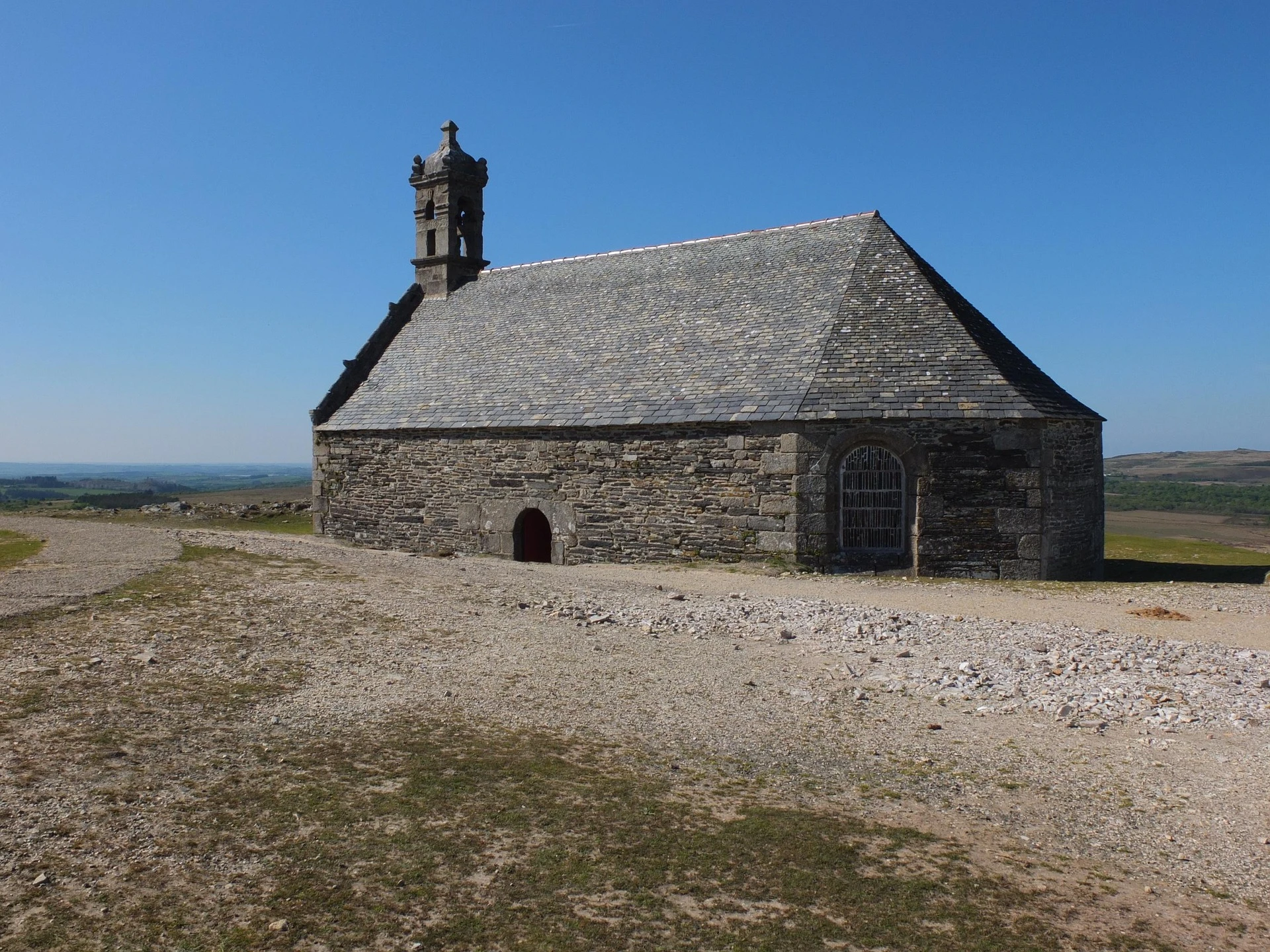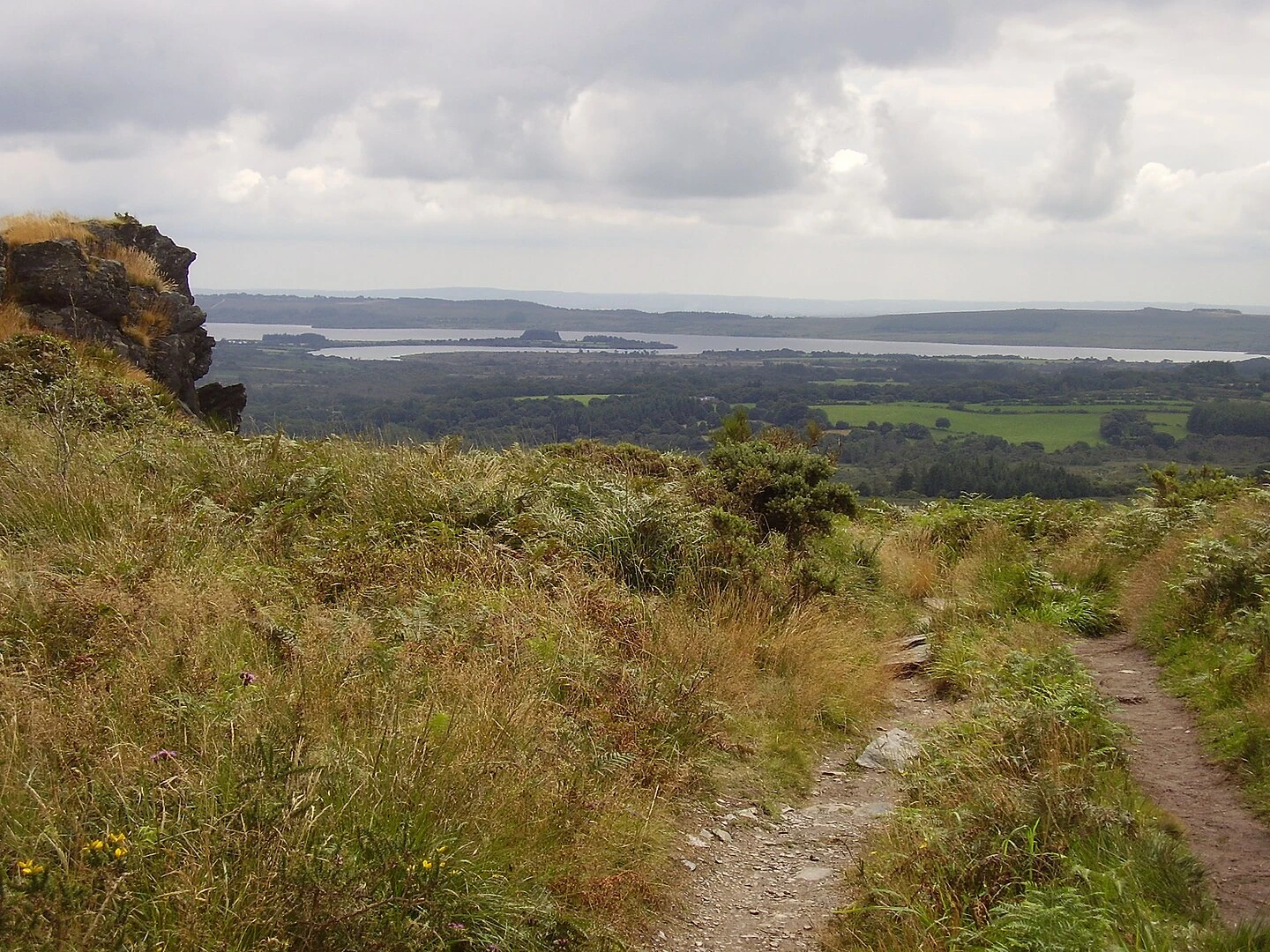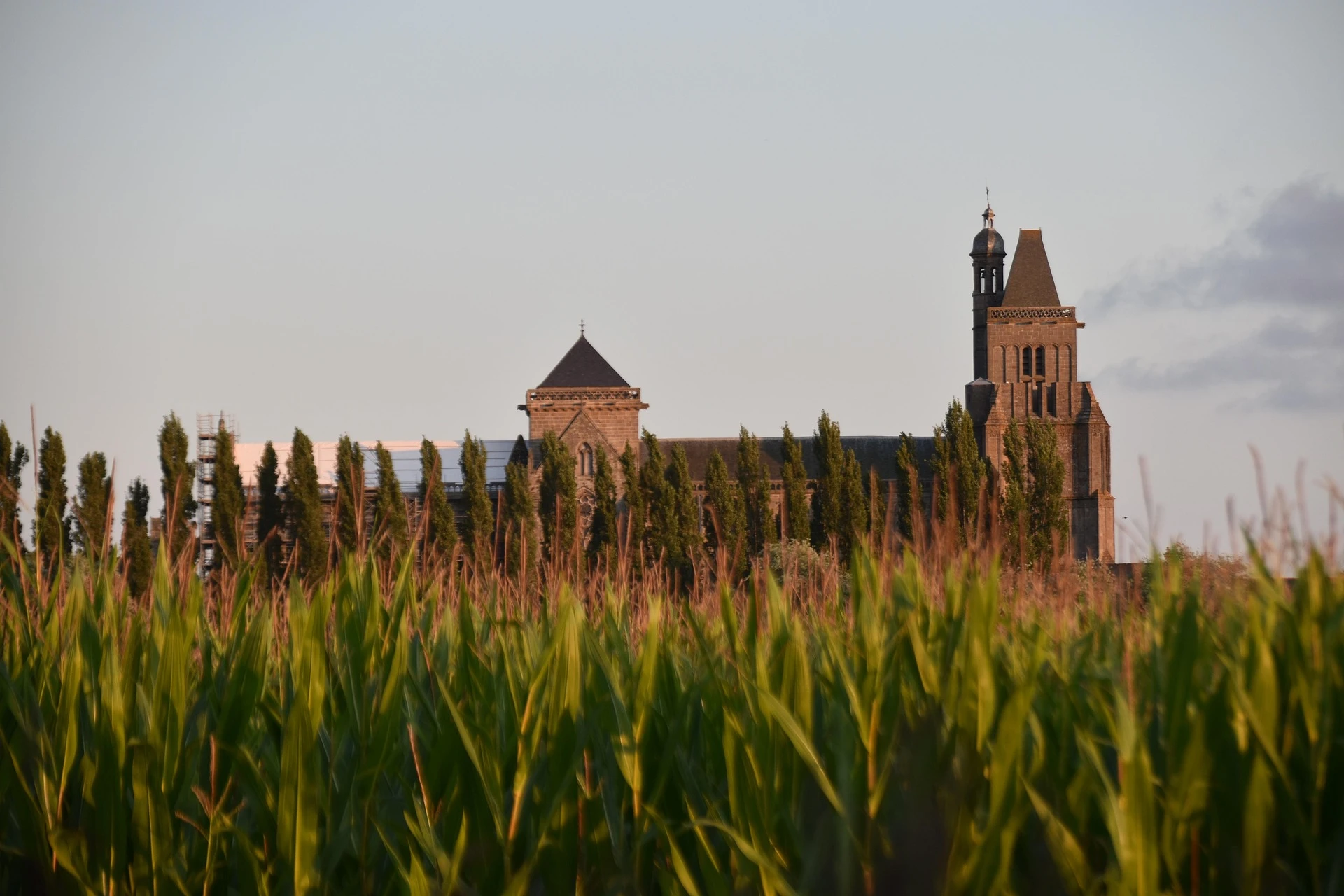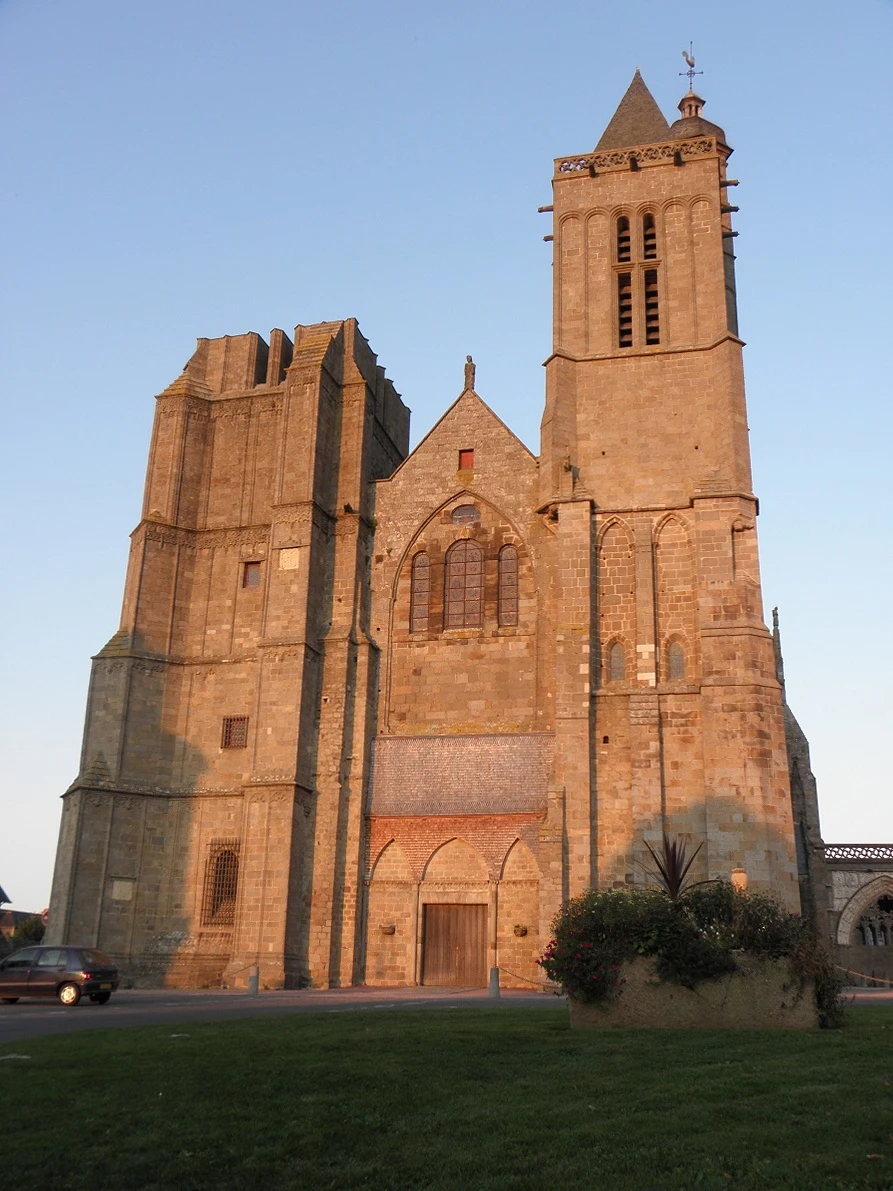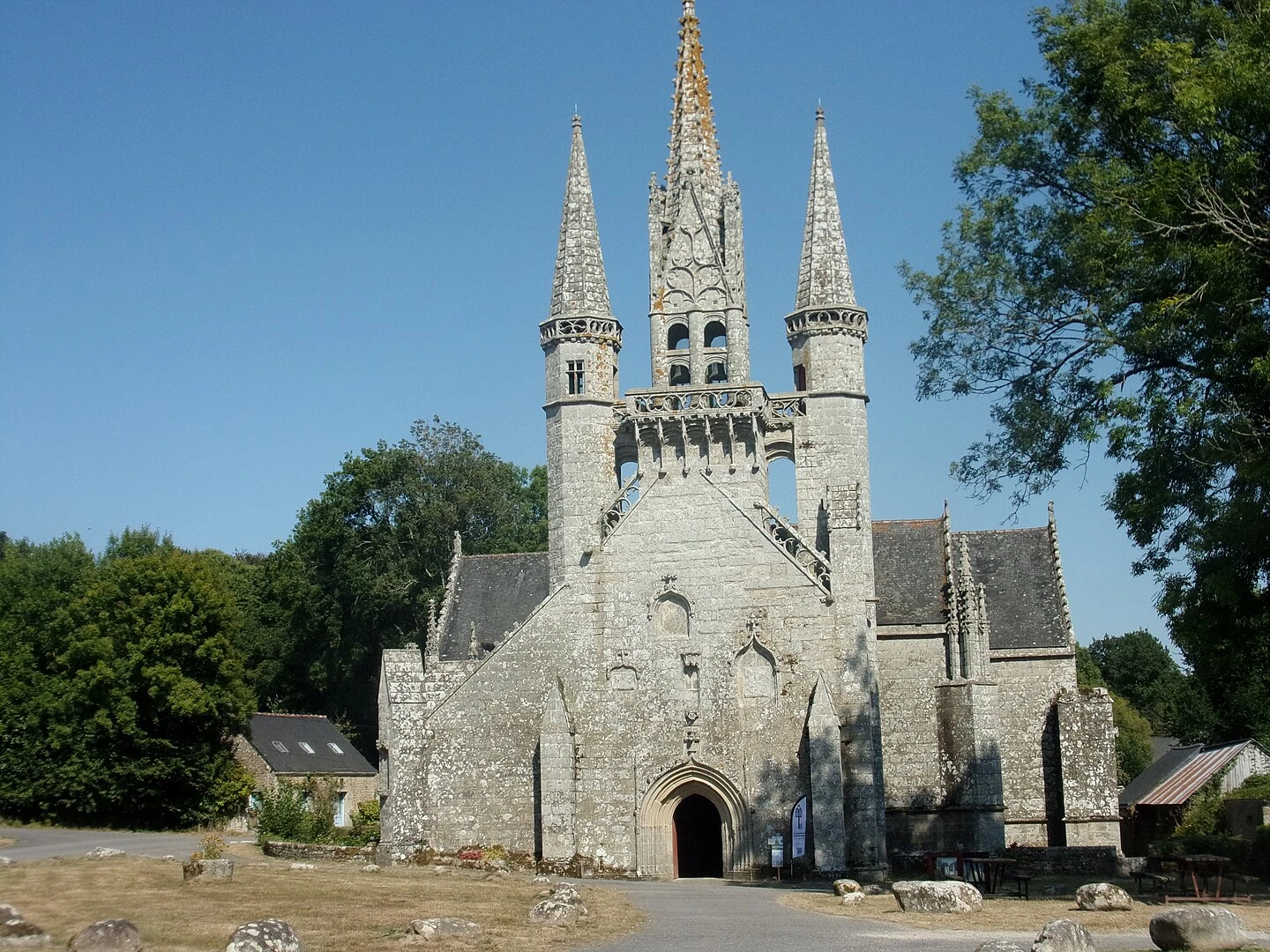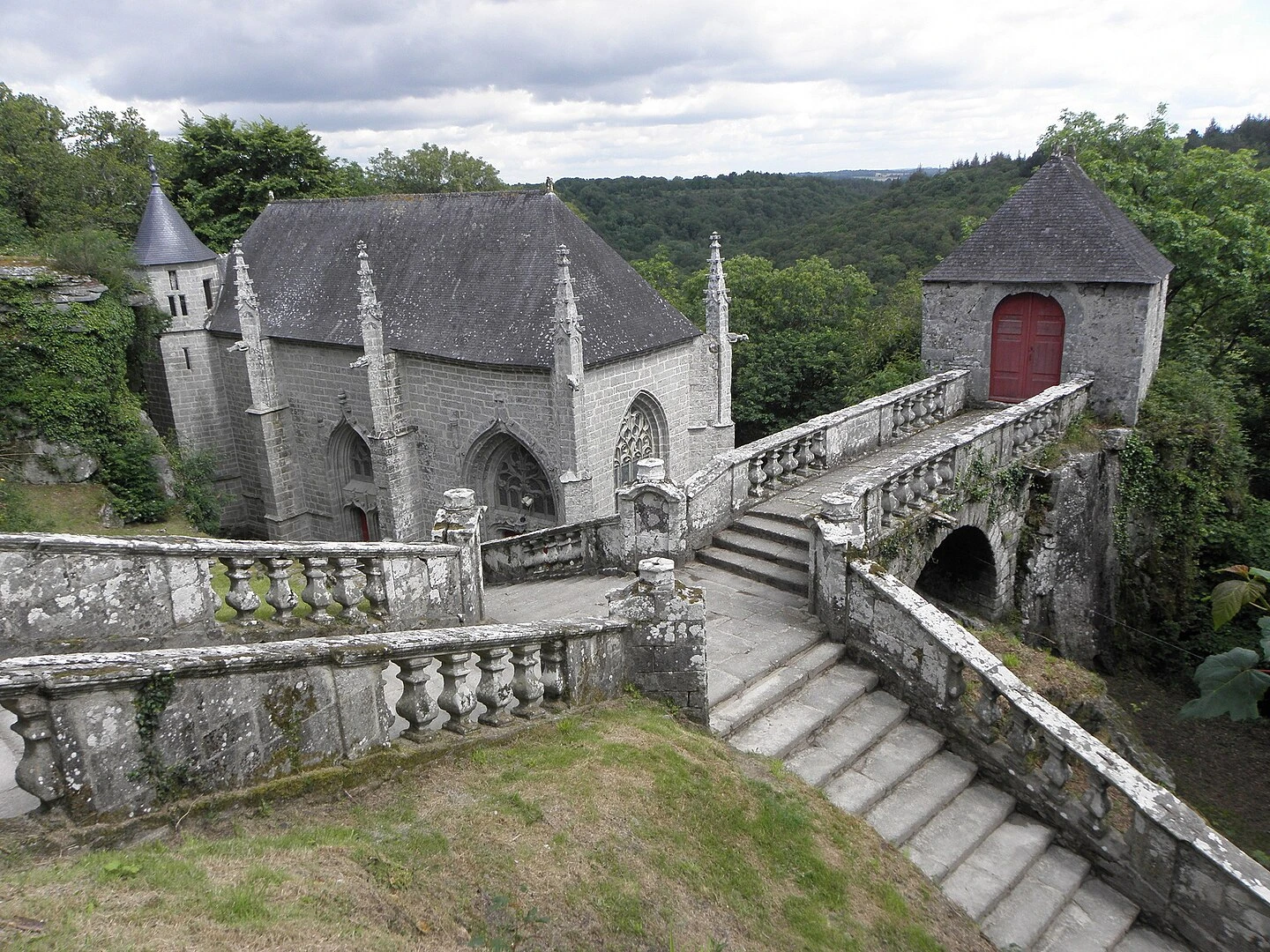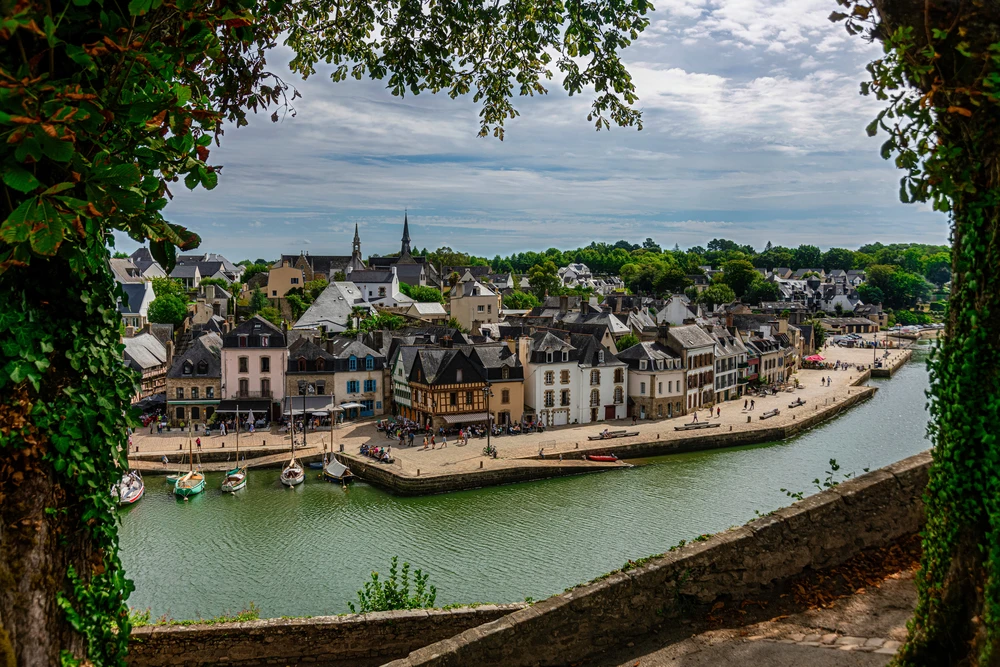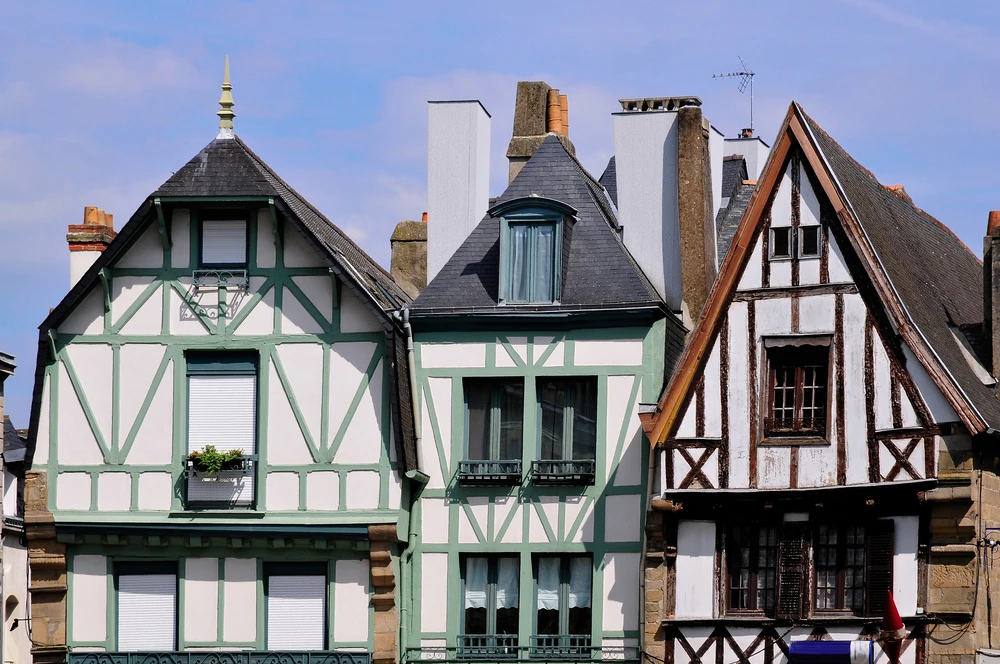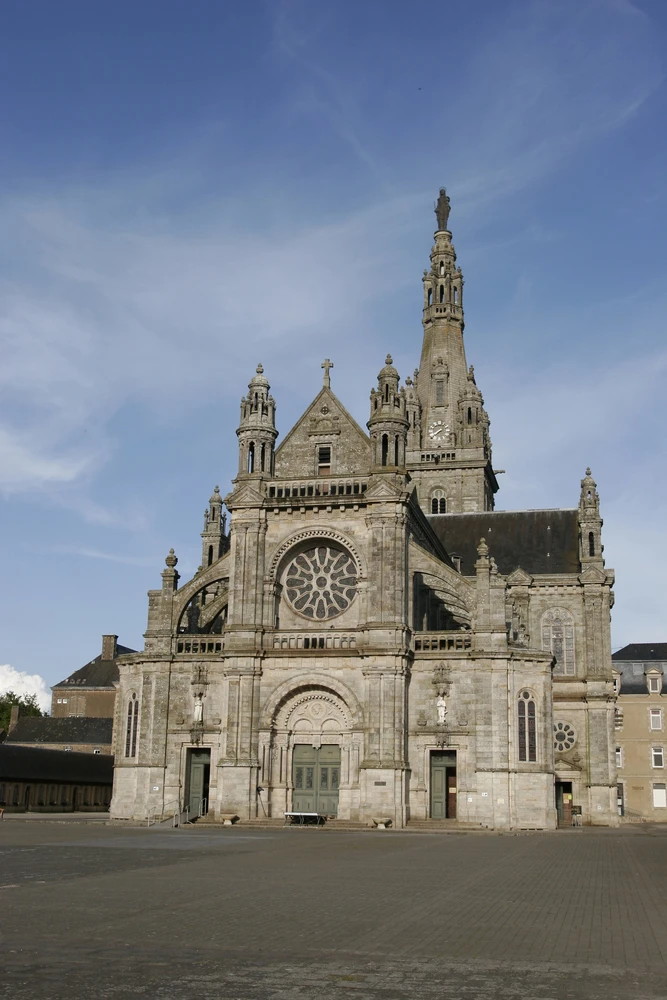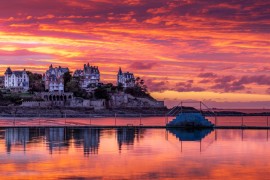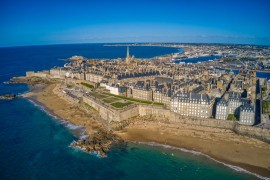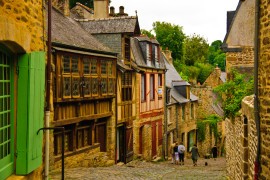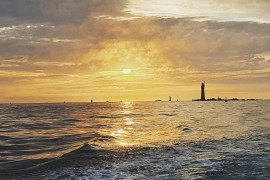1 Locronan: A Historical Treasure in the Heart of Finistère
Locronan, classified as one of France's most beautiful villages" and also a petite cité de caractère, is a Breton gem whose history dates back to Celtic times. Its name comes from Saint Ronan, a 5th-century Irish monk who came to evangelize the region. He is said to have founded a hermitage on these lands, forever marking the village's identity. From the Middle Ages onwards, Locronan prospered thanks to the sailcloth industry, an essential activity for great maritime expeditions and the royal navy. This prosperity attracted merchants and craftsmen, shaping an exceptional architectural heritage. The village has weathered the centuries without losing its soul, retaining its granite houses, Saint-Ronan church and cobbled square. Locronan is also a spiritual Mecca thanks to the Troménie, a Breton "pardon", a kind of pilgrimage. Many participants wear traditional Breton garb.
Locronan and its granite houses / Photo chosen by monsieurdefrance.com: depositphotos.
Must-sees in Locronan.
Wandering through Locronan, you'll immediately be seduced by its preserved heritage. The church of Saint-Ronan, a masterpiece of flamboyant Gothic, dominates the central square surrounded by superb granite mansions dating from the Renaissance. Next door, the Chapelle du Pénity houses the tomb of Saint Ronan. Thepaved alleyways are brimming with craft shops featuring pottery, weavings and other local Breton products. For a breathtaking view of the village and Douarnenez Bay, take the Ménez Lokorn trail, a walk offering exceptional panoramic views.
Locronan is a popular location for historical films / Photo chosen by monsieurdefrance.com: depositphotos.
What to do around Locronan?
In the surrounding area, many discoveries await you.In Douarnenez, explore the Port-Musée and stroll along the waterfront. The Crozon presqu'île offers stunning wild landscapes, perfect for hiking. Quimper, just 15 km away, appeals with its historic center, half-timbered houses and majestic cathédrale Saint-Corentin. For an immersion in the heart of nature, the Névet forest offers superb walking trails through lush vegetation.
Locronan one of the most beautiful villages in France and certainly the most typical Breton village / Photo chosen by monsieurdefrance.com: depositphotos
Locronan : Infos / distances / Websites
- Locronan is home to 806 Locronanais.
- By road, the cité is 21 minutes from Quimper / 2H35 from Rennes / 6H30 from Paris.
- By train : Gare de Quimper (then bus line 10).
- Locronan tourism website
2 Josselin medieval city and fief of the Rohan family
Josselin, the jewel of Morbihan, boasts a rich history dating back over a thousand years. Founded in the 11th century by Lord Guéthénoc,the town owes its prestige to its imposing castle. From the 14th century, the de Rohan family took possession of the site and transformed the fortress into a noble residence blending defense and refinement. Over the centuries, Josselin was the scene of numerous conflicts, notably during the War of the Breton Succession and the Wars of Religion, but its castle withstood the onslaught. Today, the residence is still inhabited by descendants of the de Rohan family, offering visitors a living testimony to Breton history. its architecture combines flamboyant Gothic and Renaissance styles, while its formal garden adds a touch of elegance. Thanks to its rich past, Josselin retains a remarkable heritage, where cobbled streets and half-timbered houses immerse visitors in a unique medieval atmosphere.
Le château de Josselin / Photo chosen by monsieurdefrance.com: depositphotos
Must-sees in Josselin
The Château de Josselin, a medieval masterpiece overlooking the River Oust, is the main attraction with its majestic towers and richly decorated interior. It was the home of the prestigious de Rohan family, whose motto was "roi ne puis, prince ne daigne, Rohan suis!". The French-style gardens are magnificent, as is the rose garden which boasts 160 different species of rose. The Musée des Poupées et Jouets anciens, located within the castle grounds, will delight young and old alike. The basilica Notre-Dame-du-Roncier, high place of pilgrimage, offers a breathtaking view from its bell tower. Strolling through the historic center, you'll discover timber-framed houses and charming alleyways.
What to do around Josselin
Nearby, several sites are well worth a visit. At Paimpont, the Broceliande forest plunges you into Arthurian legendss with mythical places like Merlin's tomb and the Barenton fountain. At Rochefort-en-Terre, listed as one of France's "Most Beautiful Villages", you'll appreciate the flower-filled lanes and its exceptional heritage. The Nantes to Brest canal offers superb walks or bike rides, particularly around Malestroit, a city of character on the water's edge. For a nature break, le lac au Duc, in Ploërmel, offers swimming and water sports in a peaceful setting.
L'Oust crosses Josselin / Photo chosen by monsieurdefrance.Com: depositphotos
Josselin : Infos / distances / Websites
- Locronan counts 2559 Josselinais
- By road, the city is located 40 minutes from Vannes / 1H from Rennes / 5H from Paris.
- By train : Gare de Josselin / Paris à 3H45.
- Josselin castle website
3 Brocéliance discover the legendary forest
L'arbre d'Or / Photo chosen by monsieurdefrance.com: unaihuizi@gmail.com via depositphotos
Brocéliande, the mythical name of the forest of Paimpont, is a place steeped in magic and mystery, whose history oscillates between reality and legend. Since the Middle Ages, this forest has been associated with the Arthurian cycle, where it is said to be home to the Fountain of Barenton, the Valley of No Return and Merlin's tomb. In medieval tales, Broceliande is the domain of fairies and enchanters, notably Viviane, the Lady of the Lake, who is said to have raised Lancelot, and Merlin, whose wisdom guided King Arthur.
Must-sees at Brocéliande.
The Brocéliande forest is packed with iconic sites linked to Arthurian legends. The Barenton fountain, reputed to make rain fall when sprinkled with water, is a mystical place where Merlin is said to have met Viviane. Le Val sans Retour, Morgane's domain, unveils striking landscapes with the Golden Tree, a symbol of rebirth after a devastating fire. Merlin's tomb, a remnant of an ancient dolmen, and the fairy mirror, a pond shrouded in mystery, are must-sees to plunge into the enchanting world of Arthurian legend.
Merlin's tomb / Photo selected by monsieurdefrance.com; depositphotos.
What to do around Broceliande?
Around Brocéliande, several sites are well worth a visit.At Paimpont, discover the abbey and its fairy-tale pond. In Tréhorenteuc, the Grail church surprises with its stained-glass windows and frescoes dedicated to Arthurian legends. Malestroit, a charming medieval town on the banks of the Nantes-Brest canal, offers a peaceful stopover with its half-timbered houses. Further north, Château de Comper is home to the Centre de l'Imaginaire Arthurien, offering exhibitions and tales on Celtic legends. Not far away, the Château de Trécesson, a medieval gem surrounded by its waters, impresses with its red schist architecture and the many legends that surround it, notably that of the Dame Blanche. For nature lovers, Lac de Trémelin offers hiking, swimming and water sports.
The superb château de Trécesson on its lake / Photo chosen by monsieurdefrance.Com: depositphotos.
Brocéliande : Infos / distances / Websites
- Brocéliande is the forest of Paimpont
- By road, Paimpont is 45 mins from Rennes / 4H28 from Paris
- By train: Paimpont station to Rennes 1H20
- Brocéliande tourism website
What we love about Brocéliande is the mystery and also all the possible variations of the color green / Photo chosen by monsieurdefrance.com: depositphotos.
4 la vallée des saints in Brittany and its monumental sculptures
The Valley of the Saints, located in Carnoët in the Côtes-d'Armor, is a site unique in the world, often dubbed "Brittany's Easter Island". This ambitious project was born in 2008 with the aim of celebrating Brittany's spiritual and historical heritage through monumental sculptures representing the region's founding saints. Inspired by Celtic legends and traditions, these granite statues, hand-carved by contemporary artists, embody the living memory of the Breton people. Each sculpture, measuring between 3 and 7 meters high and weighing several tons, is funded by patrons and bears the name of a Breton saint, whose story is told on the site. The idea behind the Valley of Saints is to create an ever-evolving cultural and spiritual space, with a goal of 1,000 statues in the coming decades. Today, the site attracts thousands of visitors every year, curious to discover this grandiose project that blends art, history and Breton identity in an exceptional natural setting.
One of the incredible sculptures in the Valley of the Saints / Photos chosen by monsieurdefrance.com: depositphotos
Must-sees at the Valley of the Saints
As you arrive at the Valley of the Saints, you'll immediately be struck by the dozens of granite statues scattered across the hillside, dominating the landscape. Each sculpture represents a Breton saint with a unique expression and posture, telling a story through stone. The panoramic view of the surrounding countryside is striking, offering an even more impressive spectacle at sunrise or sunset. A pathway allows you to explore the works freely, while guided tours provide fascinating anecdotes about these iconic figures.
Several of the works in the Valley of the Saints / Photo chosen by monsieurdefrance.com: depositphotos.
What to do around the Valley of the Saints
The region around the Valley of the Saints is packed with natural and cultural sites to explore. A few kilometers away, the town of Carhaix is famous for its Vieilles Charrues festival, but also for its Gallo-Roman heritage, with the archaeological site of Vorgium. For nature lovers, the Huelgoat forest is a must-see destination, with its legendary rocks such as Roche Tremblante and Grotte du Diable. Further south, the Nantes-Brest canal offers superb walks or bike rides along its picturesque locks. Finally, for a moment of relaxation,Lac de Guerlédan offers water sports and hiking with breathtaking panoramas of the Breton hills.
A carved woman from the Valley of the Saints in Brittany / Photo chosen by monsieurdefrance.com: Willy Mobilo via depositphotos
Carnoët La vallée des Saints: Infos / distances / Websites
- La vallée des saints is located lieu dit Quenequillec 22 160 CARNOET.
- By road, Carnoët is 42H from Rennes / 6H from Paris
- By train: Carnoët Lokarn station to vers Rennes 2H
- Vallee des saints website
5 Fougères enter a real castle
The Château de Fougères is one of the largest fortified castles in Europe / Photo selected by monsieurdefrance.com: depositphotos.
Fougères, located in Ille-et-Vilaine, is the gateway to Brittany. It's a town marked by over a thousand years of history. Its imposing castle, one of the largest medieval castles in Europe, bears witness to the town's strategic role on the borders of the Duchy of Brittany. As early as the 11th century, a first wooden fortress was built on a rocky spur overlooking the Nançon river. Transformed into stone in the 12th century, it became an essential stronghold in Brittany's defense against the French kingdom. Fougères experienced numerous sieges and battles, notably during the Hundred Years' War and the wars of succession in Brittany. In the late Middle Ages, the town prospered thanks to its textile activity, particularly tanning and leatherworking. Today, the town offers a fascinating journey back in time, with its ramparts, medieval center and cobblestone streets where history seems ever-present. A typically Breton town at the very entrance to Brittany.
Fougères / Photo chosen by monsieurdefrance.com: depositphotos
Must-sees in Fougères
Fougères castle, with its thirteen imposing towers, is the town's must-see attraction. It's a must-see if you want to know what life was like in a fortified castle. Exploring its ramparts and restored halls takes you back to the days of the Breton lords. The historic center reveals charming half-timbered houses, notably around the Place du Marchix.The Saint-Sulpice church, remarkable for its stained glass windows and twisted bell towers, is another architectural gem. Finally, the public garden, located on the heights, offers a breathtaking view over the fortress and the Nançon valley.
What to do around Fougères?
The area around Fougères is packed with sites to discover. 10 km away, the Fougères forest offers superb hiking through ancient forest paths. In Vitré, another remarkable medieval city, its castle and historic lanes are worth the detour. The Mont-Saint-Michel, around 30 km away, is a must-see excursion with its majestic abbey and breathtaking scenery. For a nature break, the Haute-Bretagne botanical park, in Le Chatellier, a few kilometers away, offers an enchanting setting with its themed gardens. Finally, for history and heritage lovers,the stunning Château de la Ballue, surrounded by remarkable gardens, is well worth a visit. Rennes is just 30 minutes away and the capital of Brittany is exciting for its architecture (and atmosphere).
Fougères castle is huge / Photo chosen by monsieurdefrance.com: depositphotos.
Fougères : Infos / distances / Websites
- Fougères has a population of 20,602.
- By road, Fougères and 30 minutes from Rennes / 30 minutes from Mont Saint Michel / 40 minutes from Saint Malo / 4H00 from Paris
- By train: Fougères station to Rennes 30 minutes. Rennes 1H30 from Paris.
- Destination Fougères website
Le château de Vitré not far from Fougères / Photo chosen by monsieurdefrance.com: depositphotos
6 Ile de Batz the little-known Breton island
Located off the coast of Roscoff, the island of Batz is a small piece of Breton land steeped in history. Inhabited since ancient times, it has played a strategic role since the Middle Ages thanks to its position between the English Channel and the north coast of Brittany.The island's history is deeply marked by the arrival of Saint Pol Aurélien in the 6th century, one of the seven founding saints of Brittany. According to legend, he freed the island from a dragon and founded a monastery, of which todaythe remains of an ancient abbey remain. Over the centuries, the island became a refuge for fishermen and sailors, developing an economy based on fishing and market gardening, notably thanks to its mild microclimate conducive to plantations. During the League Wars and the Revolution, it was the scene of numerous maritime confrontations, particularly against the English. Today, the island of Batz seduces visitors with its authenticity, its preserved landscapes and its unique heritage, where Breton traditions and wild nature blend harmoniously.
Must-sees on Batz Island
The panorama from the 42-metre high lighthouse on the Ile de Batz / Photo chosen by monsieurdefrance.com: By Metalheart - Own work, CC BY-SA 3.0, https://commons.wikimedia.org/w/index.php?curid=4773208
The island of Batz (pronounced BA) offers a varied landscape of sandy beaches, wild cliffs and farmland. The island's lighthouse, culminating at 44 meters, offers an exceptional panorama of the sea and the Breton coast. The ruins of the former Saint-Pol Aurélien Abbey recall the spiritual history of the place. The Georges Delaselle exotic garden, a true haven of peace, is home to plants from all over the world, taking advantage of the island's mild climate. As you explore the island on foot or by bike, you'll discover secret coves and typical picturesque little villages.
What to do around Batz Island?
The north coast of Finistère, opposite the island of Batz, is bursting with activities to discover. In Roscoff, departure point for the island, explore the old port, the Sainte-Barbe chapel and the famous thalassotherapy. Roscoff's exotic garden offers a green getaway with a breathtaking sea view. Just a few kilometers away, the Bay of Morlaix invites you on maritime excursions tothe Château du Taureau, a historic fortress set on the water. For beach and water sports enthusiasts, the seaside resort of Carantec offers sailing, paddle and kayaking in idyllic surroundings. Finally, the parish enclosures circuit, with gems such as Saint-Thégonnec and Guimiliau, immerses visitors in Breton religious art.
The port of Roscoff, from where you'll set off to Batz Island / Photo chosen by monsieurdefrance.com: JJFarquitectos via depositphotos
Ile de Batz : Infos / distances / Websites
- The island of Batz is populated by 457 Batziens. Access is from the port of Roscoff (price 11 euros in 2025). Crossings take 15 minutes and depart every 30 minutes in season.
- By road,Batz is 2H30 from Rennes / 6H30 from Paris
- By train:Morlaix TGV station.
- L'ile de Batz website
7 Les monts d'Arrée Land of legends and wild landscapes in Brittany
Welcome to mysterious Brittany: Allée Couverte du Mougau-Bihan in Commana, Finistère, France / Photo chosen by monsieurdefrance.com By © Rolf Krahl / CC BY 4.0 (via Wikimedia Commons), CC BY 4.0, https://commons.wikimedia.org/w/index.php?curid=1705660
The Monts d'Arrée, located in the heart of Finistère, are one of Brittany's most emblematic and mysterious landscapes. This chain of hills forms part of the Armorican Massif and is one of the highest points in the region, with Roc'h Ruz culminating at 385 metres. Marked by a vegetation of moors, peat bogs and rocky ridges,the Monts d'Arrée have always fascinated the inhabitants and fed many Breton legends. These wild lands are said to be the gateway tothe Ankou, the figure of death in Breton mythology, who prowled in the mists of the Yeun Elez peat bogs, a marsh considered the entrance to the Celtic underworld. From ancient times, these lands were traversed by Celtic peoples, who established megalithic sites and Druidic places of worship. Later, in the Middle Ages, hermits and monks settled in the region, as witnessed by the Abbey of Le Relec. Another site steeped in spirituality and mystery is the Saint-Michel chapel in Brasparts, perched on a peak overlooking the entire region. It was long a place of pilgrimage and today remains a strong symbol of the Monts d'Arrée, offering breathtaking panoramic views. Today, the Monts d'Arrée attract lovers of hiking, history and mystery, offering a unique immersion in the deep soul of Brittany.
Must-sees in the Monts d'Arrée
The Monts d'Arrée offer breathtaking scenery, with wild, unspoilt panoramas. The summit of Roc'h Trevezel offers a breathtaking view of the surrounding moors and valleys. The Yeun Elez marsh, enveloped in mists, is a mythical place steeped in mystery.The Saint-Michel de Brasparts chapel, built in the 17th century, overlooks the region from the top of its hill and offers a grandiose panorama of the Monts d'Arrée. Le Relec Abbey, a medieval vestige in the heart of nature, testifies to the monastic presence in the region. Finally, the Roc'h Trédudon ridge, another high point, offers spectacular hiking trails amidst an almost mountainous setting.
La chapelle Saint Michel de Brasparts / Photo chosen by monsieurdefrance.com : by Eric de Pixabay
What to do around the Monts d'Arrée
The area around the Monts d'Arrée is packed with natural and cultural sites to explore. In Huelgoat, the famous enchanted forest reveals fascinating rock formationss such as the Roche Tremblante and the Grotte du Diable. At Commana, the parish enclosure of Saint-Derrien is a typical example of Breton religious art. Further north, Lac Saint-Michel is ideal for fishing and nature walks. The village of Sizun boasts a remarkable heritage, with its parish enclosure and 16th-century bridge.The Musée des vieux métiers vivants in Argol offers an immersion in Brittany's artisanal past. Finally,the Armorique regional nature park, which encompasses the Monts d'Arrée, offers a multitude of commercial activities hiking, birdwatching and discovering Breton traditions in the surrounding villages.
Mont d'Arrée: Infos / distances / Websites
- The central point is the commune of Plounéour-Menez
- By road, Plounéour Menez is 50 mn from Quimper / 2H10 from Rennes / 6H30 from Paris
- By train: Plounéour Menez or Concarneau TGV station
- Monts d'Arrée website
Plounéour-Ménez, Roc'h Trevezel, Brittany / Photo chosen by monsieurdefrance.com : By Kamel15 - Own work, CC BY-SA 3.0, https://commons.wikimedia.org/w/index.php?curid=5537397
8 Dol de Bretagne and the cathedral from "The pillars of the earth".
Dol-de-Bretagne, located in Ille-et-Vilaine, is one of Brittany's oldest cities, with a history dating back to antiquity. Its fame truly began in the 6th century, when Saint Samson, a Welsh monk and one of the seven founding saints of Brittany, settled here to establish a bishopric. Very soon, Dol became an influential religious center, attracting pilgrims and scholars and playing a major role in the structuring of Breton Christianity. For several centuries, its bishopric was one of the most powerful in the region, even competing for autonomy with the archbishopric of Tours. Its spiritual influence was such that Dol became a key stage on the Tro Breizh, the sacred pilgrimage of the Bretons.The most majestic symbol of this rich history is undoubtedly Saint-Samson Cathedral, a Gothic masterpiece built between the 13th and 14th centuries. Its massive architecture and impressive stained glass windows make it an essential part of Brittany's heritage. The cathedral, which still bears witness to the city's religious prestige, recently received special support: in 2022, British author Ken Follett, celebrated author of Pillars of the Earth , made a donation to save the monument, touched by its history.
The stunning cathedral of Dol de Bretagne / Photo chosen by monsieurdefrance.Com : Image by JackieLou DL de Pixabay
Must-sees in Dol-de-Bretagne
Dol-de-Bretagne is packed with architectural and natural treasures to explore. Saint-Samson Cathedral is the town's flagship monument, impressive for its height and majestic Gothic style. Inside, its colorful stained glass windows and great organ offer visitors a fascinating spectacle. La Grande Rue des Stuarts, the town's main medieval thoroughfare, is lined with remarkably well-preserved timber-framed houses, testifying to Dol's past prosperity. To learn more about the art of building cathedrals, the Cathédraloscope is a must-visit: this interactive museum immerses visitors in the world of medieval builders. Finally, a few kilometers away, le Mont-Dol, a rocky promontory overlooking the bay of Mont-Saint-Michel, offers a spectacular panorama. This natural site, once a pagan sacred place, today houses a chapel and a stone mill that add to the charm of the area.
What to do around Dol-de-Bretagne ?
The area around Dol-de-Bretagne is brimming with exceptional sites, between nature and heritage. Just 20 km away, Mont-Saint-Michel, a UNESCO World Heritage site, is a must-see. its abbey perched on its rock and its medieval streets attract millions of visitors every year. Not far away, Cancale is a popular destination for its renowned oyster production, which can be tasted right on the port. 25 km away, Combourg is another major historical landmark. Its château, home to writer François-René de Chateaubriand, overlooks a superb lake and offers a plunge into the history of Breton Romanticism. For a maritime getaway, Saint-Malo can be reached in less than 30 minutes. This famous corsair town, surrounded by imposing ramparts, offers a unique atmosphere with its cobbled streets, sandy beaches and rich maritime history. Finally, Dinard, an elegant seaside resort some 30 kilometers away, entices with its Belle Époque ambience, coastal promenades and sumptuous villas. The Clair de Lune promenade, in particular, is a must for enjoying the exceptional views over the sea and the nearby town of Saint-Malo..
Dol de Bretagne and its cathedral with its unfinished bell tower / Photo chosen by monsieurdefrance.com : By GO69 - Personal work, CC BY-SA 3.0, https://commons.wikimedia.org/w/index.php?curid=17292217
Dol de Bretagne : Infos / distances / Websites
- Dol de Bretagne is populated by 5786 Dolois
- By road, Saint Malo is 20 minutes away / Le Mont Saint Michel is 20 minutes away / Rennes is 50 minutes away / Paris is 4H
- By train : Dol de Bretagne station.
- Dol de Bretagne and Mont Dol website
9 Le Faouët: Brittany prays and artists paint
The facade of the Saint Fiacre du Faouêt chapel / Photo chosen by monsieurdefrance.com: By Cadouf - Personal work, CC BY-SA 4.0, https://commons.wikimedia.org/w/index.php?curid=134426551
Located in the Morbihan department, Le Faouët is a small town of character whose history dates back to the Middle Ages. Cit's also a spiritual Mecca. The Saint-Fiacre and Sainte-Barbe chapels, built between the 15th and 16th centuries, illustrate the importance of the village in medieval times. Sainte-Barbe, perched on a rocky promontory and surrounded by legends, has held pilgrims for centuries. As for Saint-Fiacre, it is famous for its rood screen. From the 19th century onwards, Le Faouët became a center of inspiration for numerous artists. Painters and illustrators, seduced by the authenticity of the village and the beauty of the Breton landscapes, immortalized local life and traditions. Thus was born the École du Faouët, an artistic movement bringing together artists fascinated by rural Brittany. Today, this heritage is brought to the fore in the Musée du Faouët, which exhibits a rich collection of paintings and works illustrating the daily life of Bretons in the centuries.
Must-sees at Le Faoët
Le Faouët has an exceptional heritage that deserves to be discovered. The 16th-century halles, impressive for their wooden framework, are the historic heart of the village.The Sainte-Barbe chapel, nestled atop a wooded cliff, offers a breathtaking view over the Ellé valley and fascinates with its history linked to miracles and pilgrimages. The Saint-Fiacre chapel, with its finely sculpted Gothic rood screen, is a veritable work of art in its own right. Finally, the Musée du Faouët allows visitors to admire works by the École du Faouët, highlighting local history and traditions through painting.
Le Faouët (Morbihan), Sainte-Barbe chapel and Saint-Michel oratory: overall exterior view. Image chosen by monsieurdefrance.com ; By GO69 - Own work, CC BY-SA 3.0, https://commons.wikimedia.org/w/index.php?curid=21796761
What to do around Le Faouët
The area around Le Faouët offers many opportunities for cultural and natural discoveries. The nearby Coatloc'h forest is ideal for a nature hike through woods and green paths. In Quimperlé, Sainte-Croix Abbey, built in the 11th century, is a masterpiece of Breton Romanesque art well worth a visit. For lovers of wild landscapes, the Gorges du Corong, located some 30 kilometers away, offer an impressive sight with their granite chaos and hiking trails winding between huge boulders. Water sports enthusiasts can take advantage of the region's rivers. At Gourin, the Château de Tronjoly and its large park invite you to take a stroll in a verdant setting, while the town is also known for its strong tradition of emigration to America and its annual giant crepe festival. Finally, some thirty kilometers away, Pont-Aven, famous for having welcomed Paul Gauguin and the Pont-Aven School, seduces with its picturesque charm and art galleries, making this town a must-see for culture and painting enthusiasts.
It's also an incredible nature destination / Photo chosen by monsieurdefrance.com : By LPLT - Own work, CC BY-SA 3.0, https://commons.wikimedia.org/w/index.php?curid=26036450
Le Faouët : Infos / Distances / Websites
- Le Faouët is populated by 2816 faouettais
- By road, Quimper is 53 mn / Rennes is 2H00 / Paris is 6H00
- By train : Gare de le faouët
- Tourism website
10 Auray and Saint Goustan
The port of Saint Goustan / Photo chosen by monsieurdefrance.com: depositphotos
Auray, located in Morbihan, is a town with a rich historical past, whose origins date back to the Middle Ages. Its development is closely linked toits port of Saint-Goustan, which became a strategic point for Breton maritime trade from the 13th century onwards. Located on the River Auray, this natural harbor welcomed ships from all over Europe, promoting trade with England, Spain and the ports of the Atlantic seaboard. Auray thus became a prosperous economic center, exporting wine, salt and cereals, while welcoming goods from the rest of the world. The history of Saint-Goustan took on even greater significance in 1776, when Benjamin Franklin, sent by American insurgents to negotiate an alliance with France, landed in this port before heading to Versailles. This historic passage testifies to Auray's importance in international relations at the time. However, in the 19th century, the development of the railroads and major industrial ports led to the gradual decline of Saint-Goustan. Despite this, its medieval charm and half-timbered houses remain intact, attracting visitors today in search of authenticity and Breton history. Auray is also a mecca for Breton spirituality, thanks in particular to its link with Sainte-Anne-d'Auray, Brittany's largest pilgrimage center dedicated to the patron saint of the Bretons..
Auray and Saint-Goustan must-sees.
Old houses are superb in Auray / Photo chosen by monsieurdefrance.com: depositphotos
The port of Saint-Goustan is one of Morbihan's most picturesque districts, with its timber-framed houses and cobbled streets immersing visitors in a medieval atmosphere. The 17th-century stone bridge over the Auray River offers a magnificent view of the port and its quaysides bustling with cafés and street performers. The Place Saint-Sauveur, the heart of the old port, is a must-see place to stroll and admire the period facades. In the upper town, theChurch of Saint-Gildas, built in the 18th century, impresses with its architecture.
What to do around Auray?
The area around Auray is full of natural and heritage treasures to discover. Just 10 km away, Sainte-Anne-d'Auray is a must-see for lovers of history and spirituality. Its impressive basilica welcomes thousands of pilgrims every year to pay homage to Brittany's patron saint.15 km away, the Gulf of Morbihan offers an exceptional setting for sailing and discovering Breton islands such as Île-aux-Moines and Île d'Arz. Carnac, famous for its megalithic alignments dating back several millennia, lies some twenty kilometers away and is a fascinating visit for fans of archaeology and ancient mysteries. For a more maritime excursion, La Trinité-sur-Mer is a dynamic port popular with sailing and seafood enthusiasts. Finally, Vannes, the historic capital of Morbihan, with its ramparts, medieval center and marina, is a lively town not to be missed. There's no shortage of beaches all around Auray.
The Basilica of Notre Dame d'Auray / Photo chosen by monsieurdefrance.Com: depositphotos
Auray : Infos / distances / Websites
- Auray is populated by 15,000 alréens.
- By road, Quiberon, Carnac are nearby / Vannes is 18 minutes away / Rennes is 1H30 away / Paris is 5H00 away.
- By train: Auray TGV station
- Tourism website

